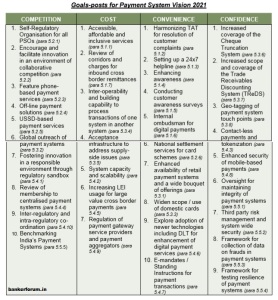RBI has recently released the Vision 2019-21: Payment and settlement systems in India based upon the report submitted by Nandan Nilekani Panel. The document states that Reserve Bank of India (RBI), under powers from the Payment and Settlement Systems Act, 2007, has endeavoured to ensure that India has ‘state-of-the-art’ payment and settlement systems that are not just safe and secure, but are also efficient, fast and affordable.
Click here to download the RBI official report
Here are the main points mentioned in the report:
Payment systems vision 2018: review and achievement
- Payment Systems Vision 2018 aimed at building ‘best-in-class’ payment and settlement systems through four strategic pillars:
-
- Responsive regulation;
- Robust infrastructure;
- Effective supervision;
- Customer centricity.
- Sizable shift from paper to digital transactions;
- Systemically Important Financial Market Infrastructures (SIFMIs), like the Real Time Gross Settlement (RTGS) system and Financial Markets Clearing through Clearing Corporation of India Ltd. (CCIL), dominate in value terms.
- Launch of new products like UPI and Bharat QR Code;
- Increased use of Aadhar in payment systems. However, the matter is under review after the intervention of Supreme Court regarding the use of Aadhar data;
- Digital transaction turnover as proportion of GDP increased from 7.14% in 2016 to 8.42% in 2018;
Payment Systems Vision 2021
Empowering every Indian with access to a bouquet of e-payment options that are safe, secure, convenient , quick and affordable
Main aims of the vision are:
- Enhancing the experience of the customer;
- empowering payment System Operators and Service Providers;
- enabling the Eco-system and Infrastructure;
- putting in place a Forward-looking Regulation;
- supported by a Risk-focussed Supervision.
The vision has set 36 specific action points with a 36 month timeframe to achieve the following specific goals:
- Further decrease in the share of paper-based clearing as a percentage of retail payments. To achieve the volume of cheque-based payments at less than 2.0 % of the retail electronic transactions by 2021.
- Accelerated growth in individual retail electronic payment systems, both in terms of number of transactions and increased availability. Payment systems like UPI / IMPS are likely to register average annualised growth of over 100 % and NEFT at 40 % over the vision period. The number of digital transactions is expected to increase more than four times from 2069 crore in December 2018 to 8707 crore in December 2021;
- the digital payment transaction turnover against GDP is expected to further increase to 10.37 in 2019, 12.29 in 2020 and 14.80 in 2021. Payment transaction turnover, including CCIL transactions and paper, is expected to be 22.30 times the GDP by December 2021.
- Increase in use of digital modes of payment for purchase of goods and services through increase in debit card transactions at PoS by 35%;
- Usage of debit cards at PoS transactions is expected to be at least 44 % of total debit card transactions at PoS + ATM.
- to have 5 million active PoS by end 2021; digital PoS (QR code) is also expected to increase substantially; and the total card acceptance infrastructure will be upscaled to six times present levels by end 2021;
- The enhanced availability of PoS infrastructure is expected to reduced demand for cash and thus over time achieve reduction in Cash in Circulation (CIC) as a percentage of GDP.
- 50% increase in the mobile based payment transactions;
- increased usage of such digital platforms would gradually lead to a reduction in the cost of the digital transactions;
- Decrease in Technical declines of transactions at 10% per year and at 5% pa for business declines; along with improvement in Turn-Around-Time (TAT) for resolution of customer complaints;
- Fraud to Sales (FTS) ratio to be decreased to 10bps for most payment systems;
- Enhanced healthy competition in the payments space and establishment of new PSOs during the Vision period is envisaged.
Main goal-posts of the vision are:
- Competition: enhancing competition in payment system landscape; creating regulatory sandbox, authorizing new players;
- Cost: presence of multiple players and stakeholders is expected to achieve optimal cost;
- Convenience: availability of service anytime-anywhere;
- Confidence: ‘no compromise approach’ towards safety of payments systems

Advantages of digitalisation
- excess reliability on cash entails some amount of cost for the economy, which can be mitigated by making a transition to the digital modes of transaction;
- savings on account of the benefits of digitalisation of economy would ultimately reflect in the rationalization of prices, which would further benefit the ultimate consumer.
- Increased turnover of digital transaction to GDP would lead to further lowering of the cost of digital transactions, giving them a further impetus.
Steps taken by RBI
- RBI would continue it’s minimal intervention in the procing of charges to the customers for digital payments; but service providers will have to set the pricing structure that is transparent, affordable and non-restrictive to the public;
- With regard to the customer complaint redressal, recourse to technology-driven dispute redressal mechanisms that are rule-based, transparent, customerfriendly and involve minimum (or no) manual intervention will be advocated / encouraged / appreciated.
- The payment service industry level Self-Regulatory Organisation(SRO) proposed in this Vision can facilitate the setting up of an industry wide 24×7 helpline and the large-scale use of technology for customer assistance and complaint redressal.
- RBI would conduct several studies, surveys and awareness drives to popularize and assess the level of awareness regarding the digital transaction platforms;
- The Reserve Bank has also put in place an ombudsman scheme for digital transactions. While PSOs have set up their own mechanism for addressing customer complaints, there is a need to formalise an internal ombudsman in the PSOs so that there is an avenue for swift and cost-effective complaint redressal mechanism within the organisation.
- RBI has also set the aim of reducing the cost of foreign remittance through formal channels. This is one of the priority areas in the G20 discussions as well.
- Self Regulatory Organization (SRO): it will serve as a mediator between the main service-providers (like banks) and the regulator, and set up standards like minimum benchmarks, and address deviations from set standards;
- RBI is also considering the betterments in the existing platforms like NEFT and UPI, to add more features to make them faster, more reliable and effective.
- Innovation towards low-cost acceptance devices will be encouraged with a view towards cost reduction, enhanced safety and ubiquitousness.
- Acceptance Development Fund (ADF): Creation of an ADF to subsidise acquirers for deploying PoS acceptance infrastructure in tier-3 to tier-6 centers. This would help in facilitating innovation and reducing cost of such transactions.
- RBI is also actively working on geo-tagging the various financials institutions and point of service delivery across the country.
- RBI has already permitted participation of non-banks in certain payment infrastructure; RBI will initiate discussion to develop a framework for settlement risk management with increased participation of non-banks.
- Legal Entity Identifier (LEI) system envisages identification of unique parties to financial transactions across the globe and is designed as an important component for improvement in financial data across the globe. RBI is in process to implement the LEI to minimize the possibility of frauds and unauthorized transactions;
- Adoption of Distributed Ledger Technology (DLT) for financial services has been a subject of interest. Various views espouse that adoption of DLT can enhance the operations of payment systems by improving the quality of data and providing additional information for payment transaction, which help automated reconciliation and reversal with high degree of precision. Adoption of DLT will be considered to facilitate industry wide adoption for areas which can benefit from this technology.
- In order to have a co-ordinated approach towards regulation, the Reserve Bank shall engage with the other sectoral regulators – SEBI, IRDA, TRAI, etc., to remove frictions in regulation and ease system operator / customer comfort. The endeavour will also to have a coordinated approach to regulation and supervision within Reserve Bank across the different related departments.

Information Courtesy: RBI
Happy Reading!
Team Bankerforum
